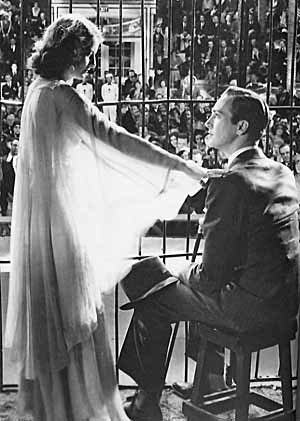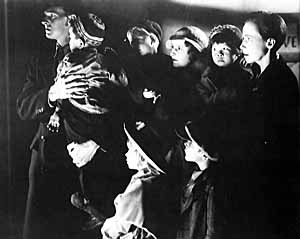In 1930, when Frank Capra agreed to interview her for a role in his next movie, she showed up sullen, without makeup, ready for yet another disappointment. And when Capra suggested a screen test, she rose to her feet, said he couldn’t care less about hiring her, and stormed out of the interview. Her husband, Frank Fay, rushed to her defense and into Capra’s office with an audition reel of Barbara playing a scene from her Broadway success, The Noose. Capra relented and a quick screening was arranged. He expected to see nothing special, but when the scene finished, he had a lump in his throat. He called Harry Cohn, the cigar-chomping dictator of Columbia Pictures, and urged him to sign her. And from that moment, her Hollywood star began her rise.
Playing a golddigging party girl with a heart of gold in Ladies of Leisure, Barbara found her first big screen success and a mentor, Capra, with whom she would work on three more movies in the next three years. But at the same time, she also worked at Warner Brothers, having signed non-exclusive contracts with both studios. As a result, her early characters were somewhat schizophrenic. She would play a sophisticated modern woman in Illicit (Warners), followed by a dance-hall girl in Ten Cents a Dance (Columbia), and then a protective hard-as-steel nurse in Night Nurse (Warners).
Unlike Joan Crawford, whose characters nearly always attempted to hold onto some self-esteem, Stanwyck’s characters would embrace decadence and selfishness in some roles (Baby Face) and wholeheartedly give themselves to motherly love and self-sacrifice in others (So Big).
While Crawford and Stanwyck both occasionally played opportunistic women (Crawford in Possessed and Stanwyck in Baby Face), Crawford’s opportunism was undercut by naivete. Stanwyck, on the other hand, rarely played naïve characters. Her characters had been around and they knew the score. In Baby Face, she eagerly gives herself to a chubby personnel clerk to get her foot in the door of a Wall Street company, and she then proceeds to sleep with everyone who can advance her career. Crawford’s characters wouldn’t start at the bottom. They’d find the men in charge rightaway and woo them. In Possessed, for example, Crawford promptly finds herself a powerful lawyer (Clark Gable) when she hits the big city. There’s no sleeping around with little fish. Only the big cheeses.
Much of these differences came out of the studios they hailed from. MGM was indeed the glamour capital and their stars fit that mold, particularly Crawford. But Columbia stars weren’t groomed like MGM’s. With a looser structure, Columbia placed its actors in wider ranges of roles. Some might say the approach lacked discipline and focus and played a much weaker part in creating stars.
Her movies with Capra at Columbia also cast her into a wide variety of characters, from the fiery-eyed faith healer in The Miracle Woman to the meek librarian in Forbidden who suddenly spends all her bank roll on an Caribbean cruise to the missionary in The Bitter Tea of General Yen who is trapped in China during a civil war and wooed by a Chinese warlord.
Meanwhile at Warners, she starred in movies like So Big, which allowed her to try out the self-sacrificing mother, a type of role she would perfect in Stella Dallas just 5 years later. And Ladies They Talk About, a blissfully absurd farce, where she plays a gun moll sent up river when a bank robbery goes awry.
The common thread between so many of these characters was their meager means of survival. Born in Brooklyn, New York to a poor family, and orphaned after her mother died and her father deserted, Barbara projected a no-nonsense attitude from early in her career. Her upbringing was hard and it showed in her "what you see is what you get" attitude. Columbia and Warners capitalized on these qualities by casting her in roles that made good use of her down-to-earth qualities.
In Shopworn, for example, she plays a small-town waitress who reaches the big-time as an actress, but the specter of her past haunts her, and thus the title of the movie. And in Purchase Price she plays a tough-as-nails nightclub singer who flees her gangster boyfriend for the wheat fields of the Midwest and becomes the mail-order bride of a farmer.
Most of the women she played were innately good, such as the mother in So Big or the nurse in Night Nurse. But even when she played a predatory woman, as in Baby Face, the film strongly suggests that her upbringing is to blame and that she can mend her ways, with the help of love.
At this point in her career, Barbara had yet to acquire the sophisticated air and the confidence that she projected in Lady Eve or Meet John Doe (both 1941). But her later roles would usually play off of her no-nonsense attitude, from the nightclub dancer on the run from gangsters in Ball of Fire (also 1941, what a year!) to the tyrannical cattle baron in Forty Guns (1957). Her image would change slightly as she aged from the scrappy newcomer of the early thirties, to the confident seductress of the forties, to the assured businesswoman of the fifties. The no-nonsense approach always played an important role in her career. When she played characters who strayed from the no-nonsense approach, the characters frequently became homicidal or psychotic, as in Double Indemnity (1944), The Strange Love of Martha Ivers (1946), and The File on Thelma Jordan (1950).
Whatever roles she played, Barbara Stanwyck brought a forthrightness and an immediacy to her characters that made them compelling even when they were the nastiest women on the screen.













 James Cagney
James Cagney Joan Crawford
Joan Crawford




